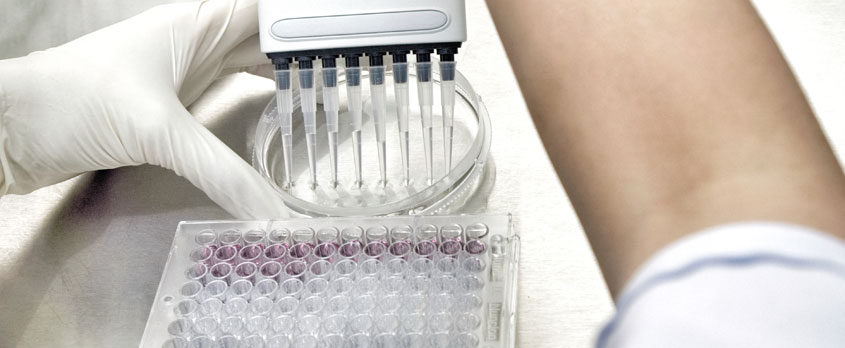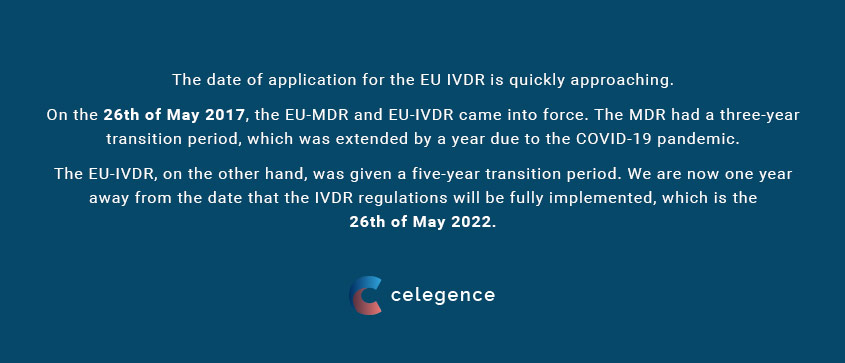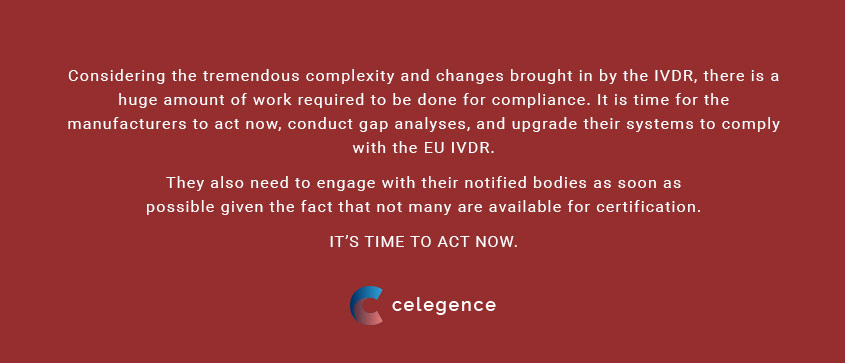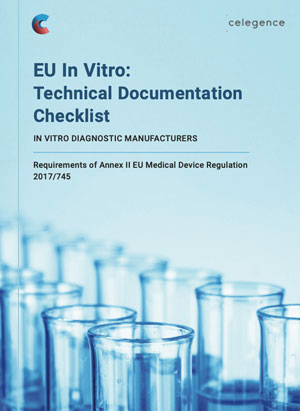
EU IVDR Key Dates
The date of application for the EU IVDR is quickly approaching. On the 26th of May 2017, the EU-MDR and EU-IVDR came into force. The MDR had a three-year transition period, which was extended by a year due to the COVID-19 pandemic. The EU-IVDR, on the other hand, was given a five-year transition period. We are now one year away from the date that the IVDR regulations will be fully implemented, which is the 26th of May 2022.
The End of IVD Directive 98/79/EC
What does this mean for the IVD Industry? The IVDR replaces the IVD Directive 98/79/EC, bringing in drastic change to the regulatory requirements as compared to the IVD Directive. The IVDR is all set to bring in a multi-fold increase in the level of stringency, scrutiny, accountability, and responsibility which was not as apparent in the Directive. Most importantly, for the many devices that are being sold under the self-certified mode of CE marking, these devices will now be up classified under the IVDR, and manufacturers may not be able to place them on the European markets anymore unless certain conditions are met. This is potentially a huge business loss for manufacturers.
It is imperative for the IVD industry to understand the changes brought in by the new regulation. First, let us understand why the regulation brought in such a colossal change.

Why did the EU IVDR Change?
The IVD Directive was published and came into force in the late 90’s, more than 20 years ago. It was considered suitable for the devices available at that time. After the 90’s, there has been a massive change in the IVD Industry with many new innovative technologies being introduced in the market. These new technologies have led to the launch of varied types of devices, for instance, cancer testing, genetic testing, companion diagnostics, predictive testing, and many more. In other words, the IVD Directive became outdated and did not cater to these new products.
Another major reason for this change was that there were many disgraceful events that rocked the medical device industry. Of particular concern were the hip implant and breast implants scandals. The first issue was about wearing away of the metals chromium and cobalt from hip implants and entering the blood stream causing metal poisoning. This has had far reaching effects on those patients who received these implants. The second issue was related to the manufacturer using silicone oil in the breast implant manufacture which was not of medical grade. The breast implants started rupturing prematurely causing scarring and inflammatory reactions in the patients who received them. Both these cases affected large number of patients and this led to public outcry over the events.
The aim of manufacturers and regulators is to provide devices that are safe, effective, and do not cause harm to the patients or users. The safety issues that occurred negatively impacted the faith of the European people on the medical device industry, as well as on the regulations in place to protect patients. The need for change and a strengthening of the IVDD was strongly felt by industry, the regulators, and the end-users. At about the same time that the MDD was to being revised to the MDR, the IVDD was also sought to be revised to address all the concerns over safety and effectiveness of devices and to keep it aligned with the MDR, other global regulations, and novel technologies.
The checklist highlights all of the documentation that you will need in place for certification of your IVD device and will serve as a guide to help you achieve ongoing compliance. In conjunction with this checklist, we are also able to provide you with bespoke strategies to bring your business up to speed. We are currently working with businesses from the United States, India, and throughout Europe to ensure that they are ready for the deadline in May of 2022.
Key Changes Brought in by IVDR
- Elevation from Directive to Regulation: This itself is a major change. A directive is adopted by the EU Member States along with their own National legislations, but there is scope for the member states to interpret it differently. However, a regulation is mandatory and leaves no flexibility for any other interpretation and therefore, will be applied uniformly across the European Union at the same time. This also emphasizes the stricter oversight of the industry by the Regulatory bodies.
- Reach of the IVDR: Under the IVDD, only about 20% IVD products come under the Notified Body Under the IVDR, a good 80% of the products, if not more, that are sold in the European markets will now come under the scrutiny of the notified bodies and are regulated.
- Scope of the IVDR: The definition of an in vitro diagnostic medical device itself changed to include some new products. This is outlined in the IVDR in Article 2 (see table 1). All reagents, controls, calibrators, instruments, apparatuses, specimen receptacles, and even software come under the regulation. The latest technologies can be accommodated under the scope of the regulation. The products that do not have diagnosis as their intended use are not covered by the regulation, for e.g.research only products, fitness applications, drug of abuse products used for law enforcement, material used for external quality assurance schemes, or certified reference standards.
- Classification of the IVDs: The IVDD has two lists – List A and List B as per Annex II and a lot was left to the manufacturer’s interpretation. With the introduction of the IVDR, a risk-based approach classifies the products into four risk classes Class A, B, C and D, based on ten implementing rules and seven classification rules (see Table 2). It is the intended use defined by the manufacturer that firstly defines whether a product is an IVD, and if it is an IVD, what the classification should be. New types of technologies and software or apps are classified using their own specific rules.
- Level of Scrutiny: The risk increases from Class A through Class D and along with it, the stringency and level of scrutiny. The requirements for each class and the involvement of the notified bodies increase with the risk class. Apart from the regular audits conducted by the notified bodies, they will now conduct unannounced audits of manufacturers once every five years. Secondly, the notified bodies themselves have to be designated and approved for IVDR conformity assessments by the Competent Authorities. As of today, in May 2021, there are only four notified bodies approved for IVDR assessments across the IVD industry, and this may later become a bottleneck as the date of application comes closer. They will also be closely supervised by Competent Authorities.
- GSPRs: The new 20 GSPRs or General Safety and Performance requirements of the IVDR replace the 13 essential requirements of the IVDD. Not only does this mean an expansion of requirements, but it means there is more explicit detailing. Conformity to the GSPRs is mandatory.
- Economic Operators: This is a new term introduced by the EU-MDR/IVDR. It means the manufacturers, authorized representatives for non-EU manufacturers, importers, and distributors. The obligations of each are clearly defined by both the regulations, which makes them legal requirements. A new and mandatory role, Person Responsible for Regulatory Compliance (PRRC) has also been introduced. The Manufacturer and Authorized Representative must have at least one person as a PRRC, with their criteria for fitting into this role (as well as their responsibilities) being well defined in Article 10. Traceability is now clearly seen along the supply chain. Therefore, a whole lot of accountability and responsibility has been brought in, aiming at better control for the regulators and safer products out in the markets.
- Transparency and Traceability: Apart from the supply chain, the IVDR has brought in improved traceability and transparency with the help of the EUDAMED database. This is a secure web-based portal already operational to a certain extent, but more modules are to be added to it. It includes registration for the manufacturer and other economic operators with complete contact details and complete information about the devices, their performance data, their certificates, vigilance and post market surveillance. It will be accessed by competent authorities, notified bodies, economic operators, and even end-users will be able to access some of this information. Thus, transparency and accountability has been brought into the system.
- Traceability with UDI: The Unique Device Identifier UDI system has been introduced in the EU. This system already exists in the US medical device world. It allows all IVDs to be traced, across the globe, with the help of a unique bar code i.e., numeric, or alphanumeric coding. It has two parts to it – the UDI-DI, which identifies the manufacturer, and the UDI-PI, which identifies the unit of device production giving details such as lot nos., serial nos., and manufacturing or expiry dates.
- Performance Evaluation: There are increased expectations for performance evaluation, and they are far more clearly defined compared to the IVDD. Moreover, a life cycle approach is emphasized, due to which sufficient data related to performance and safety needs to be collected as a continuous process throughout the lifetime of the product. The results of performance evaluation generate clinical evidence, and this is further linked to risk management, thereby ensuring strict control at all stages of the device. The report contents and timelines are defined clearly. The IVDR has made it clear that there is no “grandfathering” for legacy devices and all devices to be placed on the EU market simply must conform to the IVDR.
- Documentation: There are now far stricter requirements for conducting and documenting performance evaluation, and especially vigilance and post market surveillance. These elements are now much more clear, precise, and well defined. The SSP– Summary of Safety and Performance is newly introduced. The PMS plan, PSUR – Periodic Safety Update Report and PMPF which is the post market performance follow-up are new too.
- Financial Liabilities: The provision of sufficient financial coverage for potential liability claims is now a mandatory obligation for the manufacturer and the EU Authorized Representative.

IVDR Gap Analysis
Considering the tremendous complexity and changes brought in by the IVDR, there is a huge amount of work required to be done for compliance. It is time for the manufacturers to act now, conduct gap analyses, and upgrade their systems to comply with the EU IVDR. They also need to engage with their notified bodies as soon as possible given the fact that not many are available for certification. It’s time to act now.
The checklist highlights all of the documentation that you will need in place for certification of your IVD device and will serve as a guide to help you achieve ongoing compliance. In conjunction with this checklist, we are also able to provide you with bespoke strategies to bring your business up to speed. We are currently working with businesses from the United States, India, and throughout Europe to ensure that they are ready for the deadline in May of 2022.
Table 1: In vitro diagnostic medical devices include any –reagent, reagent product, calibrator, control material, kit, instrument, apparatus, piece of equipment, software or system, whether used alone or in combination, intended by the manufacturer to be used in vitro for the examination of specimens. This includes blood and tissue donations, derived from the human body, solely or principally for the purpose of providing information on one or more of the following:
(a) concerning a physiological or pathological process or state;
(b) concerning congenital physical or mental impairments;
(c) concerning the predisposition to a medical condition or a disease;
(d) to determine the safety and compatibility with potential recipients;
(e) to predict treatment response or reactions;
(f) to define or monitoring therapeutic measures.
Specimen receptacles and accessories are also covered by the IVDR.
| Class of Device | Risk |
| Class D | High risk to the patient and a high risk to public health |
| Class C | High risk to the patient and/or medium risk to public health |
| Class B | Moderate individual patient risk and/or low public health risk |
| Class A | Low risk to the patient and low public health risk |
Table 2: Classification of devices under the IVDR



